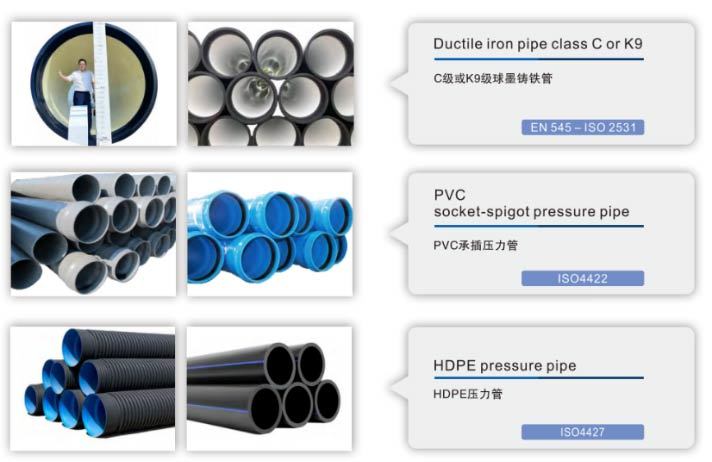Water supply pipes and connection methods
Release time:
2024-03-25
 1. Water supply pipes
1. Water supply pipes
(1) Gray cast iron pipe
Gray cast iron can withstand common water pressure (generally ≤0.75Mpa), can meet common needs in terms of strength (tensile limit ≤1.4Mpa, bending limit 2.4-3.4Mpa), is easy to install, and is cheap. Cast iron pipes are also corrosion-resistant and can be used for hundreds of years without damage by simply coating the surface with a layer of asphalt. It is easier to process and cut, and it is also more convenient to drill holes and turn threads. The disadvantage is that it is heavy. According to different working pressures, they are divided into different pressure levels.
(2) Ductile iron pipe
In addition to having all the advantages of gray cast iron pipes such as corrosion resistance and easy processing, ductile iron pipes also have good elongation, and the thickness of the pipe wall is only 2/3 of gray cast iron pipes, so it can save a lot of steel. . At present, ductile iron pipes are widely used in the United States, Japan, France, Germany and other countries. Ductile iron pipes all use flexible interfaces. my country's national standards stipulate the technical requirements for ductile iron straight pipes, pipe fittings, rubber rings, etc. for annealed centrifugal casting for water transmission. All ductile iron pipe products produced in my country must comply with current national standards. According to wall thickness or pressure-bearing capacity, ductile iron pipes are divided into four grades: K8, K9, K10, K11 and K12. Those not specified in the contract shall be supplied as K9.
(3) Steel pipe
Steel pipes are divided into ordinary steel pipes, galvanized steel pipes and seamless steel pipes. The surface of steel pipes is galvanized to prevent rust and corrosion. It is suitable for domestic drinking water pipes or some industrial water pipes with higher water quality requirements to avoid affecting the water quality (because zinc is harmful to the body, galvanized steel pipes are no longer used for drinking water transportation). water); ordinary steel pipes are used for non-domestic drinking water pipes or general industrial water supply pipes; seamless steel pipes are used for high-pressure pipes, and their working pressure is above 1.6Mpa. Steel pipes can withstand high pressure. The test water pressure of ordinary grade steel pipes must reach 3-6Mpa. If the test pressure is 1.5 times the working pressure, the working pressure is 2-4Mpa, which far exceeds the value specified for gray cast iron pipes and also exceeds the regulations for ductile iron pipes. value. There are two types of steel plates used in manufacturing steel pipes: killed steel and boiled steel. Killed steel is deoxidized before casting the steel ingot, so its mechanical properties, toughness, weldability and stability at high and low temperatures are better than those of boiling steel. The main water pipes and the bottom of the boiler are made of killed steel. Boiling steel has the word "F" added to the end of the steel number, such as Q235AF, while killed steel does not add the word. Not to be confused.
In water pipelines, ordinary carbon steel Q235A is commonly used. The meaning of "A" is that it was divided into three levels according to the guarantee conditions when supplied. A is Category A, which only guarantees the mechanical properties and does not guarantee the chemical composition; the meaning of "3" is that ordinary carbon steel is divided into three levels according to its mechanical properties and cold bending The test indicators are divided into 8 numbers (0-7). "3" means No. 3 steel, which is common for general buildings. Water and gas pipelines use this kind of steel "Q235A", which is Class A No. 3 killed steel. In terms of material, steel pipes have the advantages of high pressure resistance, good toughness, thin pipe walls, light weight, easy transportation, long pipe body, and few interfaces. However, they have poor corrosion resistance and must be treated with external anti-corrosion treatment. Moreover, it needs to be thoroughly processed before treatment. The cost is very high, so it should only be used unless there is a special need. Steel pipes are generally used in large-diameter (DN600 or above) water supply pipes in outdoor pipe networks, or across railways, river valleys and other areas.
(4) Reinforced concrete pipe
(5) Plastic pipe
Plastic water supply pipes generally fall into the following categories: non-toxic rigid polyvinyl chloride pipes (UPVC) and pipe fittings; high-density polyethylene pipes (HDPE) and pipes, other thermoplastic pipes and pipe fittings, including polypropylene (PP), cross-linked polyethylene Ethylene (PEX), polybutylene (PB), acrylonitrile-butadiene-styrene (ABS), chlorinated vinyl chloride (CPVC), etc.; five-layer aluminum-plastic composite pipe (cross-linked polyethylene-adhesive-aluminum- Adhesive - cross-linked polyethylene).
2. Water supply pipe fittings
Most of the commonly used cast iron pipe fittings standards in my country above DN75mm are Japanese Kubota specifications. This is the result of historical formation. Pipe fittings below DN50mm are all threaded connections. The threads are all in imperial conical pipe thread standards. Even if some materials are written in metric, they are converted from imperial. As for non-metallic pipe fittings, there are now national standards to follow, which are relatively formal.
3. Water supply pipe interface
Regardless of the inner and outer diameters of pipes or fittings, as long as the nominal diameters are the same, they can be connected to each other and are interchangeable.
(1) Steel pipe connection method
The interfaces of steel pipes are mostly threaded interfaces and welding. In addition, there are also flange interfaces and various flexible interface types. In urban water supply projects, galvanized steel pipes for indoor water supply generally use threaded interfaces.
(2) Cast iron pipe connection method
Cast iron pipes generally use rigid interfaces and flexible interfaces. Rigid interface: linseed asbestos cement interface, rubber ring expanded cement interface. Flexible interface: rubber ring asbestos cement interface. (Ductile iron pipes all use flexible interfaces) Semi-rigid and semi-flexible interface: hemp-lead interface.
(3) Plastic pipe connection method
Rigid polyvinyl chloride water supply pipes can use rubber ring interfaces, bonded interfaces, flange connections, etc. Commonly used are rubber rings and adhesive connections. Rubber ring interfaces are suitable for pipe connections with a diameter of 63-315mm; adhesive interfaces are only suitable for pipes with an outer diameter less than 160mm; flange connections are generally used for hard polyvinyl chloride pipes Connection with cast iron pipes and other pipe valves. High-density polyethylene plastic pipes can be joined using hot melt. Polyethylene pipes are connected to metal pipes using steel-plastic transition joints. ① Rubber ring connection: Install the rubber ring correctly in the rubber ring groove of the socket. It must not be installed upside down or twisted. For the convenience of installation, you can wet the rubber ring with water first, but do not apply lubricant on the rubber ring during installation to prevent the interface from being damaged. Push out the rubber ring. ② Bonding connection The socket-type bonding interface is suitable for UPVC pipes, but not for high-density polyethylene plastic pipes. The advantages of pipe bonding are: high connection strength, tightness and no leakage, no need for special tools, and rapid construction. The main disadvantages are: pipes and fittings cannot be changed or removed after they are connected, cannot be moved or inspected before they are completely solidified, and leaks are difficult to repair.
Latest News
Centrifugal ductile iron pipe is widely used and develops rapidly
The main purpose of ductile iron pipes is to help our lives become more convenient. In the country, ductile iron pipes are manufactured in order for our people to live more effectively in the daily lives of society and to develop more rapidly in our careers. It can make our lives more and more advanced and make our development faster and faster. When we build houses, especially when we build factories, we must have a stable job and have good fixation tools to stabilize the buildings of our factories. However, ductile iron pipes are a good helper. They can It plays a very good stabilizing role and makes our factory buildings more stable. It also allows our workers to enter the factory with confidence and do not have to worry about any sudden events, such as fires or explosions. Even if something like this happens, ductile iron pipes can be very stable and support the factory well.
2024-03-25
Introduction to Ductile Iron Pipe
Ductile iron pipe fittings are one of the accessories of ductile iron pipes. It includes elbows, tees, reducers and sockets, etc. Material: gray iron, ductile iron Specifications: DN15-DN300 (mm) Use: used in water supply, drainage and gas transportation pipeline systems, can withstand pressure water supply pressure 0.02MPa-0.6MPa. Working temperature: -45°C ~ 150°C Applicable media; water and oil characteristics:
2024-03-25
How to identify inferior ductile iron pipes
1. Ductile iron pipes are prone to folding. Folds are various fold lines formed on the surface of ductile iron pipes. This defect often runs throughout the longitudinal direction of the product.<br> 2. Inferior ductile iron pipes often have pitted surfaces on the surface. The pitted surface is an irregular uneven defect on the surface of the ductile iron pipe caused by severe wear of the rolling groove. As manufacturers of low-quality ductile iron pipes pursue profits, groove rolling often exceeds the standard.<br> 3. The surface of inferior ductile iron pipes is prone to scarring.<br> 4. The surface of inferior materials is prone to cracks because its raw material is adobe, which has many pores. The adobe is subject to thermal stress during the cooling process, causing cracks, and cracks appear after rolling.<br> 5. Inferior quality ductile iron pipes are easily scratched. The reason is that the equipment of inferior material manufacturers is simple and easy to produce burrs, which can scratch the surface of ductile iron pipes. Deep scratching reduces the strength of ductile iron pipe.<br> 6. Inferior ductile iron pipes have no metallic luster and are light red or similar in color to pig iron. If you don’t know how to choose when purchasing, use these six points and you will definitely not buy inferior ductile graphite tubes.
2024-03-25
Water supply pipes and connection methods
Gray cast iron can withstand common water pressure (generally ≤0.75Mpa), can meet common needs in terms of strength (tensile limit ≤1.4Mpa, bending limit 2.4-3.4Mpa), is easy to install, and is cheap. Cast iron pipes are also corrosion-resistant and can be used for hundreds of years without damage by simply coating the surface with a layer of asphalt. It is easier to process and cut, and it is also more convenient to drill holes and turn threads. The disadvantage is that it is heavy. According to different working pressures, they are divided into different pressure levels.
2024-03-25
Anti-corrosion treatment methods for ductile iron pipes
Asphalt paint coating is used for pipelines transporting gas. Preheating the pipe before painting can improve the adhesion of the asphalt paint and speed up drying.
2024-03-25
What is the European standard implementation standard for thin-walled stainless steel water pipes?
At present, thin-walled stainless steel water pipes basically use 304 or 316 materials, and kettles and cups on the market also use this material, which indicates that stainless steel materials are increasingly recognized as water pipes. Stainless steel water pipes, no matter how many years you use them, are bright and will not have sediment. Now many water pipes are placed outdoors, and they will be frozen and damaged in winter, but stainless steel water pipes will not have these problems, and they have good frost resistance. In addition, stainless steel water pipes can be managed to the end, there are no joints in the middle of the water pipes, and have good corrosion resistance.
2024-03-25



